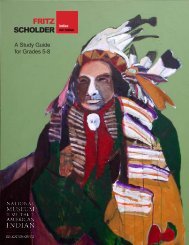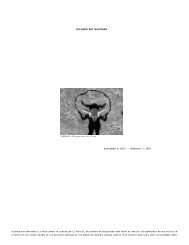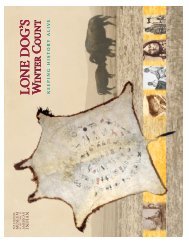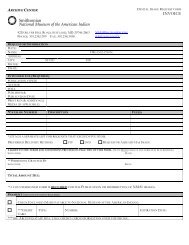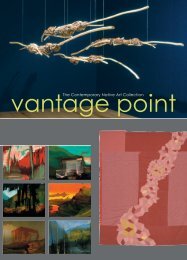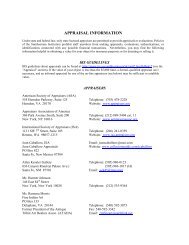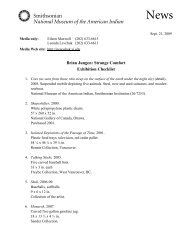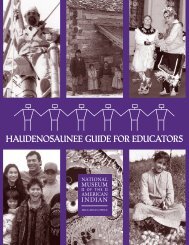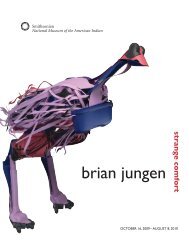Download the brochure (PDF) - National Museum of the American ...
Download the brochure (PDF) - National Museum of the American ...
Download the brochure (PDF) - National Museum of the American ...
- TAGS
- download
- brochure
- nmai.si.edu
Create successful ePaper yourself
Turn your PDF publications into a flip-book with our unique Google optimized e-Paper software.
JOSE ´ ANTONIO ANCAN ´<br />
JARA<br />
MAPUCHE<br />
REGIÓN DE LA ARAUCANÍA, CHILE<br />
SCULPTOR, WRITER<br />
VISITING ARTIST, 2003<br />
My proposal is based<br />
on <strong>the</strong> analysis <strong>of</strong><br />
ethnographic<br />
materials from <strong>the</strong><br />
Mapuche community<br />
held in existing<br />
museum collections.<br />
Since that material is<br />
virtually unknown<br />
in its original context,<br />
simply recognizing<br />
it creates a significant<br />
advance in increasing<br />
<strong>the</strong> value and<br />
promotion <strong>of</strong><br />
Mapuche culture.<br />
42<br />
Contained in <strong>the</strong> extensive bibliography on<br />
<strong>the</strong> Mapuche people is a valuable set <strong>of</strong><br />
photographs <strong>of</strong> Native people from different<br />
communities who were taken prisoner<br />
by Argentinean soldiers at <strong>the</strong> end <strong>of</strong><br />
<strong>the</strong> 19th century. Standing out among <strong>the</strong>se<br />
images are several <strong>of</strong> Saiweke, <strong>the</strong> last<br />
Mapuche community leader to lay down<br />
his arms. His life was extensively docu-<br />
mented by <strong>the</strong> many travelers who met him,<br />
but I find it curious that <strong>the</strong>re are no repre-<br />
sentations <strong>of</strong> him or <strong>of</strong> any o<strong>the</strong>r Mapuche<br />
protagonists prior to <strong>the</strong>ir imprisonment.<br />
My Native Arts Program research was based<br />
on <strong>the</strong> review and analysis <strong>of</strong> museum<br />
and ethnographic data from <strong>the</strong> Mapuche<br />
community in collections from <strong>the</strong> several<br />
museums I visited. Since that material is<br />
virtually unknown in its original context,<br />
simply seeing and recognizing it creates a<br />
significant advance in increasing <strong>the</strong> value<br />
and promotion <strong>of</strong> Mapuche culture.<br />
The article I include here draws on <strong>the</strong><br />
results <strong>of</strong> my Native Arts Program research.<br />
The first Biennale <strong>of</strong> Indigenous Art and<br />
Culture in Santiago, Chile (January 2006),<br />
showcased <strong>the</strong> work <strong>of</strong> <strong>the</strong> foremost<br />
Mapuche engraver and artist, Santos Chávez<br />
(1934-2001). Using Santos Chávez’s legacy<br />
as a departing point, <strong>the</strong> article conducts a<br />
critical reflection <strong>of</strong> <strong>the</strong> responsibilities<br />
I believe that contemporary indigenous<br />
artists have today.



